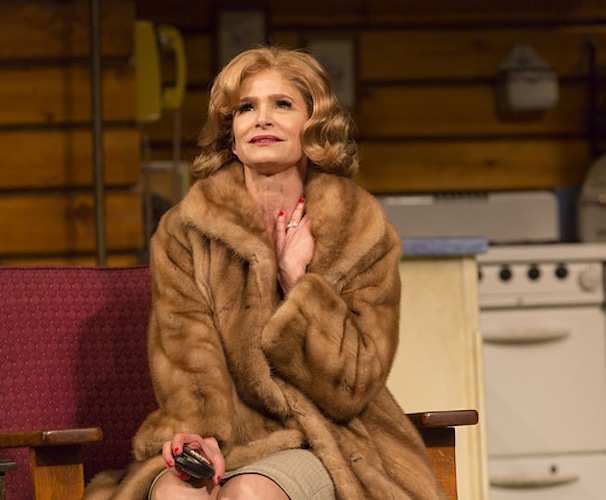Theater Review: William Inge’s “Off the Main Road” — A Major Discovery
William Inge’s Off the Main Road is both contemporary and politically incorrect in the best ways.
Off the Main Road, by William Inge. Directed by Evan Cabnet. Williamstown Theatre Festival, Williamstown, MA, through July 19.

Kyra Sedgwick (Faye Garrit) in the Williamstown Theatre Festival production of “Off the Main Road.” Photo: T. Charles Erickson.
By Helen Epstein
It’s not every day that an Artistic Director planning her first season has the opportunity to mount the world premiere production of a major play by a major American playwright. Until 2008, Off the Main Road was both an unpublished and unproduced work, held by the heirs to the Inge Estate.
William Inge (1913-1973) was a Midwesterner, born and raised in Kansas, then a drama critic in St. Louis, Missouri. A theatrical late-bloomer, he wrote his first play, Farther Off from Heaven, in 1947, then moved to New York after his drama Come Back, Little Sheba ran on Broadway and became both a film and TV special. He had a spectacular run in the 1950s with a series of plays that included Picnic, Bus Stop, and The Dark at the Top of the Stairs — all made into even more successful films. His career and private life, however, both took a dive during the ’60s and he killed himself in 1973 at the age of 60.
For a play that’s been lying in a file cabinet for 50 years, Off the Main Road — in this well-directed and superbly-cast production — is both contemporary and politically incorrect in the best ways. The script features three generations of women: Mrs. Bennet, a prototypically proper Midwestern country-club matron portrayed by a show-stopping Estelle Parsons; her daughter Faye Garrit, a pill-popping socialite married to an abusive ex-baseball hero, played by the always nuanced Kyra Sedgwick; and her 17-year-old daughter, Julia Conroy, played with astonishing range and panache by Mary Wiseman.
The year is 1966; the scene is a two-bedroom cabin in the woods on the outskirts of St. Louis, after the summer and fall vacation season is over. From the moment a visibly distressed Sedgwick rushes onto the stage in her pale mink and heels, trailed by a dumpy teenager in a parochial school uniform along with the startled landlady Mrs. Burns, it’s clear that we are in for a rich slice of American anthropology as well as high drama. The three women take us back to a time just before the tumult of the ’60s hit the Midwest. In cultural terms, it is the very end of the ’50s. Everything here — the sumptuous period set (by Takeshia Kata), the period costumes (Paloma Young), lighting (Ben Stanton), and the period sound (Ben Trupin Brown), which evokes the bland piano music of hotel lounges everywhere — commanded my attention and drew me into a character-driven work that kept on surprising me until the very end.
Did I forget the men? Maybe one of the reasons Off the Main Road remained unproduced for so long is because the males — unlike the men of their time — are largely peripheral. Inge does not see them as an admirable lot: Manny Garrit (Jeremy Davidson) has retired from the St. Louis Cardinals. He is unable to adjust to life off the field and is prone to murderous rages which his adoring fans (which include the police) repeatedly overlook; Gino (a taxi driver) doubles as a gigolo; Jimmy Woodford is an unhappy, closeted gay art dealer; and young Victor Burns, son of the landlady, is a typically callow college student. The playwright seems to know and love all of his creations: he makes them rounded characters, not caricatures — each of them deserves his attention, no matter how repulsive their actions.

(L to R): Aaron Costa Ganis (Gino) and Kyra Sedgwick (Faye Garrit) in the WTF production of “Off the Main Road.” Photo: T. Charles Erickson.
This script, which examines the varieties of love as well as abuse in the name of love, is excellent, although some of its pre-feminist lines are now cringe-inducing. I could also have done with less stage business around drinking — but Inge was an alcoholic himself and maybe that degree of imbibing was true to the play’s time and place. His empathy is evident for all his characters, even when they’re sleazy or dishonest with themselves and others. Inge is superlative at exploring the obsessions and blind spots in mother-daughter relationships; the play is filled with dialogue that is at times painfully insightful, often probing the vulnerability of American illusions. Most of the lines are delivered with great sensitivity and — yes! — spoken audibility (without the assistance of miking) by the entire cast, except Howard W. Overshown, the reclusive art dealer, whom I found difficult to hear.
Evan Cabnet’s direction is confident. This production never flags, yet it allows space and time for actors and audience to breathe and take in the moment — something that far too many stagings of contemporary plays don’t.
WTF Artistic Director Mandy Greenfield has scored an impressive coup by opening her first season with a premiere of a 50-year-old play. I look forward to her future choices.
Helen Epstein is the author of Joe Papp: An American Life and five other books, all available as ebooks from Plunkett Lake Press.
Tagged: Culture Vulture, Kyra Sedgwick, Off the Main Road, Willamstown Theatre Festival
